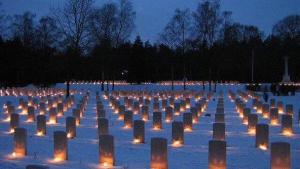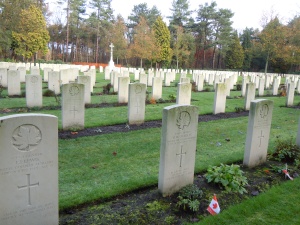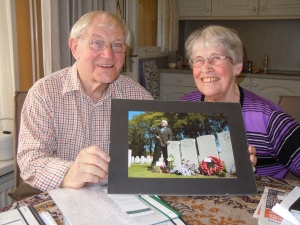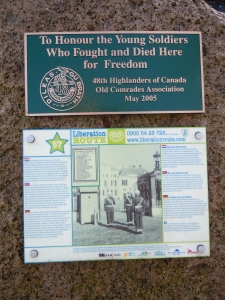Last night striking images beamed to Canada from a Canadian war cemetery in The Netherlands of elderly Canadian vets whose chests were hidden behind their medals.
Today the 105 90-something vets who made the return journey to The Netherlands to mark the 70th anniversary of the liberation are again being welcomed as returning heroes.
On May 5, 1945 the Germans surrendered to a Canadian Lieutenant General Charles Foulkes. The Dutch have remained ever grateful to Canada for their liberation.
As a Canadian visiting The Netherlands is a humbling experience because of the gratitude and respect the Dutch have for the Canadian army. There is an irony to the esteem the Dutch have for Canada’s role in the World War II because they know our history better than we do.
In December I met many people who worried that the story would be lost on future generations. Of Dutch children. And so the surviving generation do everything they can to ensure the history is not forgotten and that succeeding generations not take their freedom for granted. They have programs in schools to tell the story. Schools organize regular trips to war museums, battlegrounds and war cemeteries. Students and families adopt  graves and regularly lay flowers in remembrance on those graves. The French have a similar program. And at Christmas, Dutch families gather in the war cemeteries to place candles on each war grave. The Dutch have a passion for remembrance and their liberators.
graves and regularly lay flowers in remembrance on those graves. The French have a similar program. And at Christmas, Dutch families gather in the war cemeteries to place candles on each war grave. The Dutch have a passion for remembrance and their liberators.
On a recent trip to The Netherlands I had the honour to meet Chris Petter and his wife Meis at their home in Renkum, near Apeldoorn. For over three decades Petter has, at his own expense, bought and placed flowers on the graves of Canadian liberators.
This quiet act of remembrance wasn’t enough for Petter. He decided he had to know more about these men who gave their lives to liberate a foreign land. So even before the ease of computer research he began digging into records, writing letters and building profiles on the fallen. His research helped families at home learn what happened to their loved ones.
In the case of RCAF Flying Officer Jack Wills, who was brought down over Groesbeek, Petter found out that Jack was born in Toronto, raised in Saskatoon and lived in Edmonton where he enlisted October 1, 1941, when he was 18. Jack died three years later at age 21. Petter’s research found Jack’s father, Jacob, was a pharmacist, his mother was Mary, his sister Verna. Petter even found Jack’s fiancée Cora and put Verna and Cora in touch with each other, completing a sad story that ended in Operation Market Garden thousands of miles away from the Prairies. Cora told Petter, “Jack sure could dance. He could jive. He could jitterbug. I could dance pretty well too. We cut quite a rug.”
Petter’s passion arises from the ages – 18, 19, 20 – he sees on the thousands of

Across The Netherlands and Europe are dozens of war cemeteries with their thousands and thousands and thousands of immaculately tended graves.
Canadian tombstones in the Canadian war cemeteries. “They never ever had time to kiss a lady. I want them to have the love and respect they deserve.”
Among the graves Petter tends are: Corporal Delphin Cormier, son of Peter and Marianne Cormier, Cheticamp NS, who was a member of the Regiment de la Chaudiere, and died at age 21 on February 26, 1945, Private Armand Morais, son of Stanislaus and Clara Morais, Bellefont, NB, with the Stormont, Dundas and Glengarry Highlanders, RCIC, aged 23 when he died on February 9, 1945. In recognition of his remembrance and respect, The Queen awarded Petter an MBE.
Throughout the country you meet people who engage in staggering and heart-swelling acts. In the Canadian War Cemetery in Bergen op Zoom, which with 1,115 graves is the smallest in The Netherlands, one of the gardeners told me there are six kilometres of edging around the graves.
In the centre of Apeldoorn, which is near the German border and where the Nazis set up a headquarters and military hospital in the royal palace, is a statue of a Man with Two Hats (De man met de twee hoeden). Jan Koorenhof, who organizes remembrance celebrations in Apeldoorn and arranged for this statue explained the people were so happy at being liberated raising one hat wasn’t enough. A replica statue stands in Ottawa. Each faces the other.
The Netherlands are part of the commemorative Liberation Route (http://liberationroute.com) which traces
the footsteps of the Allies from Plymouth, England to Gdansk, Poland. The route is designed to allow people to follow parts of it or drop in to individual places and learn about a particular area’s history. There are plaques, audio stories, tours, travel offices and websites to help you organize your own experience. It’s worth giving up a beach holiday to make this pilgrimage and trying to catch up with the Dutch in learning about our history.




Interesting article Al…. We too watched this news with interest and we would someday like to travel on this Liberation Route. We have previously done the Normandy Beaches, cemeteries and some travel in Netherlands but this article piques my interest to explore the Netherlands connection in greater detail. As with you, we were warmly welcomed when we travelled in these regions……it’s wonderful to feel so welcome in a foreign country. All the best…..B
In Zeeland one family opened a museum because the local farmers kept digging up so much left over material from WWII (over 40,000 items). And because they continue to do so, the museum is tripling in size in 2016.
The National Bevrijdingsmuseum, Groesbeek is small, but also touches on civilian life. They list the 150,000 who died fighting for The Netherlands and are in the process of cataloguing over 2,000 war diaries.
The Netherlands are an inspiring little country.
Dear Brian, if you decide to travel towards Holland, do not hesitate to contact the Liberation Route Europe Foundation for more info. Although you can find a lot of information on our website and/or app already, we are always willing to help you.
Best,
Team Liberation Route Europe